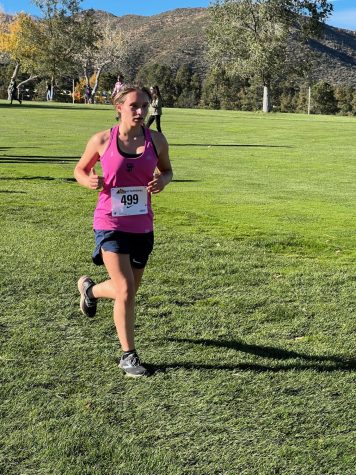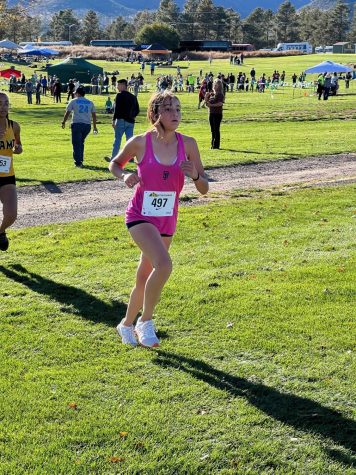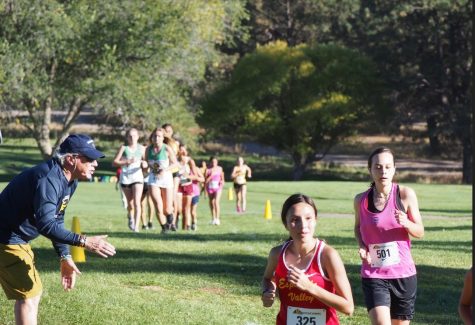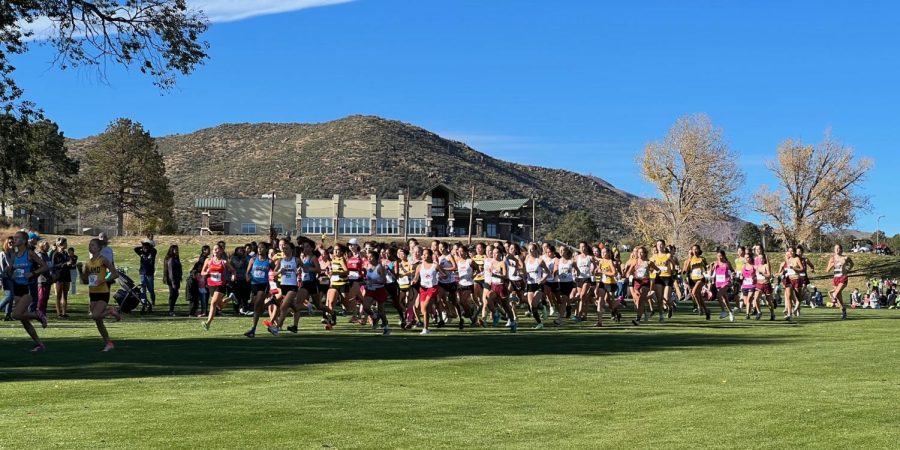Girls’ XC Places at State: A Look Inside the Sport — and the Runners
November 8, 2022
Nine Santa Fe High cross country runners competed in the Division AAAAA State Cross Country Meet on Nov. 5 at Albuquerque Academy. The girls team, led by Mandela freshman Mia Schleman, came in 11th place out of 15 teams. Every Santa Fe High runner ran their fastest time this season, with many attaining overall personal bests.
The girls’ race took place at 9 a.m. with the temperature hovering just above freezing at 33 degrees, nearly 60 degrees colder than last year’s state race. “It was so cold everyone ran a PR so we could get back to our jackets,” said one runner.
At Districts the week before, the girls team placed third overall, beating Manzano by one point to qualify for State. The boys team placed fourth, five points behind Manzano, so they did not qualify as a team. However, two boys, sophomores Valin Wittenburg and Daniel Busemeyer, qualified individually, and placed 42nd and 61st at state, respectively.



And so, in honor of a satisfactory end to the season, one runner provides an inside — and anonymous — look into what they call “probably Santa Fe High’s least popular sport.”
What is cross country all about, and who are these athletes?
Read on to learn more about Demon XC.
Practice starts at 4:30 p.m. We meet in Coach Graham’s office, drop our backpacks off. It’s a small office, but it’s a small team too. We do our warm-up outside his office: various exercises with resistance bands for injury prevention. Sometimes there’s a volleyball game happening, and we get perplexed stares from audience members.
Newcomers tend to find themselves hopelessly lost for the first few weeks. Lost in the literal sense. I remember trying desperately to cling to every word as Coach Graham explained the day’s run. Day after day, my efforts were in vain. One minute in, and every left and right turn, every esoteric landmark and street name that I had so painstakingly attempted to etch into my memory, vanished. One arroyo blended into another, one intimidating street to cross indistinguishable from the next. I was not yet used to running. My only motivation to keep running was not to lose sight of whoever was in front of me, and I felt as though some miracle had befallen me when I ended up back at Santa Fe High each day.
But eventually, I developed a familiarity with each run. We all do. We can see it mapped out in our heads at the mere mention of its name. Each one has distinct characteristics; each one is a distinct character.
There’s Fudge Run, a steady uphill along the bike path that runs parallel to the train tracks, rewarded by a flying downhill on the way back. Or Graffiti, where you run up an arroyo until you reach a giant, graffitied concrete slab, and then turn around and run back. There’s Fire Station, with the steady downhill that you don’t notice until you’re coming back on a slight uphill for two good miles.
And the list goes on: Claire’s, Jungle, Marriage, Triangle, Frogurt, Rabbit, Infinity, Cooper’s. Each one though ends the same way: with a sprint up the hill that runs parallel to the track at Santa Fe High. A few key landmarks, too, have attained such fame that they have names: Mike’s Bridge, The Tunnel, The Roundabout, The Apartments.
Then there are the meets, generally consistent from year to year. Most are on Saturday mornings. All are, in theory, a standard 3.1 miles long: 5000 meters, a 5K. In reality, they range from the 2.95 mile ATC Invitational to the unpredictable, indisputably infamous, nearly 3.3-mile Los Lunas Invitational.
There’s this whole little society of runs and landmarks and meets and secret paths and legendary stories. And if you removed just a handful of people from the world, it would all cease to exist.
Five days a week we practice:
- On Mondays, a long run, usually four to five miles, at Santa Fe High, and a handful of strides on the track afterwards.
- Tuesdays are intervals. A slow jog to Ragle Park or Chaparral, generally. A handful of interval repeats, some combination of kilometers, half-miles, and 500 meters, with a few minutes rest in between. A slog (our portmanteau of “slow” and “jog”) back to campus
- On Wednesdays, an off-campus run, somewhere in town.
- Thursdays, a repeat of Monday.
- On Fridays before a meet, an easy 2- to 2.5-mile run, talking pace. Ten strides to end the week.
Sometimes you find yourself with your teammates, on an easy day, and a most surprising conversation springs up as the beat of your footsteps keeps time in the background. At other times, you find yourself with one teammate, pacing each other, pushing each other. Some unspoken communication is occurring, for your strides slowly fall in sync. And still other times, you find yourself alone with your thoughts, the awaiting miles outstretched before you.
Long distance running really is a peculiar thing. A large part of it is clearly physical: You run six days a week for months, a couple hundred miles a season. Your legs burn and your lungs heave, and over time this translates into improvement. But equally large is the mental aspect. In many cases there’s no external impetus. There’s no ball on which your attention is focused, no screaming teammates, no roaring audience, no obvious opponent.
It’s really not like other sports. Spectators generally consist of supportive parents and teammates. Coaches are stationed sporadically throughout the course, yelling out mile splits, advice, encouragement. The occasional person clangs a cowbell. The sport doesn’t get a lot of attention, but neither does it desire any. Its unpopularity is an inextricable part of its identity.
We have eight girls: 5 from Santa Fe High, 3 from Mandela.
We have nine boys: 7 from Santa Fe High, 2 from Mandela.
Of all the students at Santa Fe High, 0.75 percent run cross country. It’s a remarkably small team, especially for a 5A school. We each get our own seat on the bus — sometimes our own row.
In a sense it’s a team sport. We push each other in practice. We high-five at the end of most every run. The girls cheer the boys on during their race; the boys cheer the girls on during theirs. In meets, we score as a team. Each finisher gets a number, equal to their place in the race. The top five numbers for each team are added up, and the lower the team score, the better the team places.
But in another sense, it is an individual activity. You see your teammates as you stand shoulder to shoulder, packed into the starting box, waiting for the gun to go off. You reunite at the finish. But there is a good chance you won’t see each other even once for the entire race. There is a good chance you won’t say a single word during the entire race. In a sense, you are racing for your team. But really, you are racing the clock: racing last week’s time, racing yourself.
So why do we run? That is a deceptively simple question. Or perhaps a remarkably easy question that is simply impossible to adequately answer with words.
I casually bring the question into conversation at an off-campus run. We are all standing in the Atalaya parking lot on a Wednesday afternoon, waiting for everyone to arrive. The question hangs in the air awkwardly. Then, “I don’t know.”
A few people echo the same, and a few more nod. It’s not “I don’t know” in the apathetic sense, not the “I don’t know” accompanied by a shrug. It’s not the “I don’t know” that means you haven’t taken the time to think about it. It’s a genuine, perplexed “I don’t know,” the kind that comes with a wrinkling of the brow and a slight tilt of the head. We are all chewing on the question.
“Well, I first joined to improve my cardio.”
“Okay, but why did you stick with it?”
“Well…”
“I do it to get in shape for track.”
“Okay, and why do you like track?”
“Because…because it’s fun? I don’t know.”
“I adore the pain.”
“I do it because my friends do it.”
“I genuinely do like it. Or maybe it’s just because of the dopamine rush.”
“I wanted to do sports but have no hand-eye coordination.”
Scattered laughter.
This question is not working. I decide to veer the conversation in a different direction, hoping we will inadvertently stumble across the answer.
“What do you think about when you run?”
“Like in a meet?”
“Sure, let’s start there.”
“In my head I just repeat, ‘Don’t stop, don’t stop, don’t stop.’ For 25 minutes.”
A similar but subtly distinct answer: “Keep going, keep going, keep going.”
“I think about the finish.”
“I cry internally.”
“I focus on my breathing.”
“I just tell myself I’ll be disappointed if I don’t do well.”
“That’s kind of dark.”
“Well, I mean it works.”
By now we have started running. I fall in with a group of four others and try to reignite the conversation. When you’re running in a group, who says what fades into irrelevance. It’s a conversation with others, but sometimes it feels like a conversation with yourself.
“We do like running, right?” someone inquires. Perhaps not the best question to be asking this far into the season.
“Well, we’re sad when we don’t run. So we must.”
“But then is running just a drug? Do we only like it because we are addicted to it?”
“But it’s good for you.”
“Well, coffee is technically a drug and it’s still good for you.”
“Actually the research is still up in the air on that.”
“No, coffee is definitely a drug.”
“I meant the good-for-you part.”
We are running up Upper Canyon Road. The conversation scatters and fades away. We reach an intersection. We have gone 1.7 miles. Three members of the group turn back. I keep going, along with another girl. We continue at a steady pace.
There is a giant looming hill before us. It is bathed in shadow and a bit chilly as a result. There is a slight breeze coming at us, probably not strong enough to make our ascent physically any harder, only psychologically. We turn a corner and the hill keeps going. The burn in our legs intensifies, as does the urge to stop. But given the nature of our sport, we are well accustomed to both these feelings, and so we trod onwards.
Suddenly, the hill plateaus, and we are bathed in sunlight. We are running in the middle of the road and there’s not a car in sight. There is a panoramic view, of the hills dappled with yellow aspens, of our small town shimmering in the late-afternoon sun, of the far-reaching pastel sky adorned with wispy clouds.
Apart from our accelerating footsteps, there is silence as the plateau morphs into a downhill and the burning in our legs subsides. Only later, once the road flattens out again and a few cars appear on the road and tree cover blocks the stunning view and the moment has clearly ended, do either of us dare say a word.
Another day, we’re in the arroyo that runs alongside Santa Fe High, running slowly, day before a meet, talking.
“So much sand.” Not a complaining voice, more awestruck.
“Where does sand come from? Is it just ground-up rocks?”
“Yep.”
“That’s how old the earth is.”
The conversations ceases for a while. We’re most certainly all thinking about the very old Earth, the way time has worn down unimaginably large rocks into the sandy arroyos we were running in, the ephemeral nature of our own lives. I’m not sure why we always end up having such philosophical conversations. Maybe running harbors deep thoughts. Maybe the people who choose to do cross country are naturally introspective. I’d guess it’s both.
“So one day, will the earth just be sand?”
“Well isn’t the sun going to explode and engulf it in a few billion years?”
“Actually, the research is still up in the air on that.”
“Okay, but if nothing changed, would the Earth just be all sand one day?”
Silence. We’ve all taken enough science classes to know that the Earth ending up a giant sphere of sand is a bit outlandish, but I don’t think scientific credibility is really the point of the proposition.
Then the arroyo ends, taking the train of thought with it. We climb some steep steps up to the bike path and resume running.


